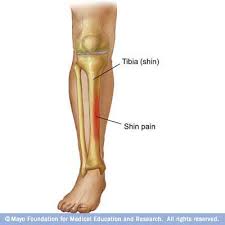
记忆方法
1. 谐音“行”----行走----不胫而走-----胫骨。
中文词源
shin 胫,胫骨,爬,攀爬
来自古英语 scinu,胫,胫骨,来自 Proto-Germanic*skino,薄片,来自 PIE*skei,切,分开,词 源同 sheathe,science.比喻用法,引申词义用腿爬,攀爬。
英语词源
- shin
-
shin: [OE] Shin has Germanic relatives in German schiene ‘thin plate’, Dutch schen ‘shin’, Swedish skena ‘shin’, and Danish skinne ‘splint’. Its underlying meaning seems to be ‘thin piece’. The first record of its use as a verb, meaning ‘climb with the hands and legs’, comes from the early 19th century.
- shin (n.)
- Old English scinu "shin, fore part of the lower leg," from Proto-Germanic *skino "thin piece" (cognates: Dutch scheen, Old High German scina, German Schienbein "shin, shinbones"), from PIE root *skei- "to cut, split" (see shed (v.)). Shin splints is attested from 1930.
- shin (v.)
- "to climb by using arms and legs" (originally a nautical word), 1829, from shin (n.). Related: Shinned; shinning.
权威例句
- 1. He made a remarkable recovery from a shin injury.
- 他的胫骨伤恢复得相当不错。
- 2. He sheathed the knife and strapped it to his shin.
- 他将刀插入鞘中,绑在小腿上。
- 3. He had the words "Angie loves Ian" tattooed on his left shin.
- 他在左小腿上文了“安吉爱伊恩”几个字。
- 4. I barked my shin on a tree stump.
- 我磕到了树桩上,胫部擦破了皮.
- 5. The horse kicked him on the shin.
- 马踢到了他的胫部.
